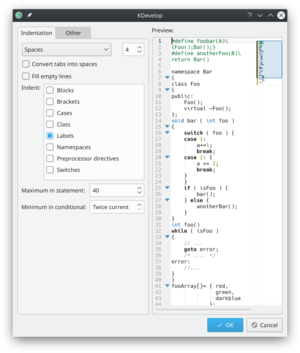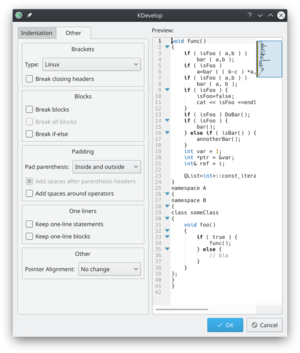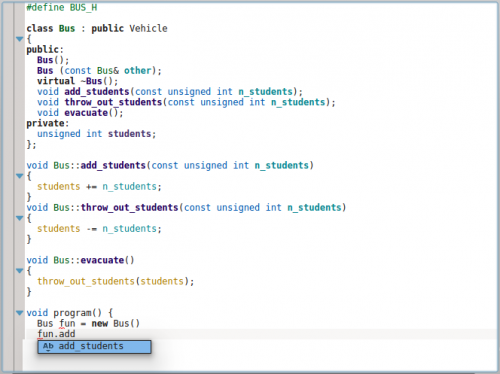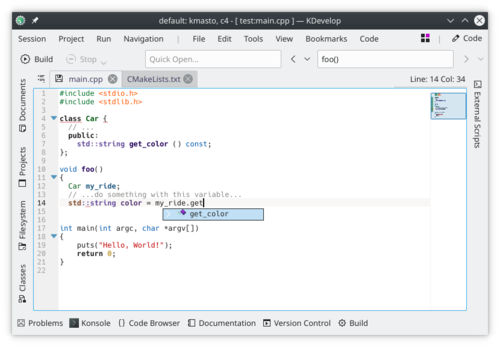KDevelop4/Manual/Customizing KDevelop/uk: Difference between revisions
No edit summary |
Created page with "=== Налаштування автодоповнення коду ===" |
||
| Line 27: | Line 27: | ||
Однією з двох корисних змін буде встановлення для <menuchoice>Вирівняти</menuchoice> скорочення <keycap>Tab</keycap> (багато хто звичайно не додає табуляції вручну і віддає перевагу вибору форматування коду редактором; якщо скорочення буде змінено, після натискання <keycap>Tab</keycap> '''KDevelop''' виконає додавання відступів, вилучення відступів або вирівнювання коду). Другою зміною буде встановлення для команди <menuchoice>Встановити/зняти точку зупину</menuchoice> скорочення <keycap>Ctrl+B</keycap>, оскільки встановлення або зняття точки зупину є доволі поширеною дією. | Однією з двох корисних змін буде встановлення для <menuchoice>Вирівняти</menuchoice> скорочення <keycap>Tab</keycap> (багато хто звичайно не додає табуляції вручну і віддає перевагу вибору форматування коду редактором; якщо скорочення буде змінено, після натискання <keycap>Tab</keycap> '''KDevelop''' виконає додавання відступів, вилучення відступів або вирівнювання коду). Другою зміною буде встановлення для команди <menuchoice>Встановити/зняти точку зупину</menuchoice> скорочення <keycap>Ctrl+B</keycap>, оскільки встановлення або зняття точки зупину є доволі поширеною дією. | ||
=== Налаштування автодоповнення коду === | |||
Code completion is discussed in [[KDevelop4/Manual/Working_with_source_code#Auto-completion|this manual's section on writing source code]]. In '''KDevelop''', it comes from two sources: the editor, and the parse engine. The editor ('''Kate''') is a component of the larger KDE environment and offers auto-completion based on words it has already seen in other parts of the same document. Such auto-completions can be identified in the tooltip by the icon that precedes it: | |||
[[Image:kdevelop-20.png|thumb|500px|center]] | |||
The editor's code completion can be customized via <menuchoice>Settings -> Configure Editor -> Editing -> Auto Completion</menuchoice>. In particular, you can select how many characters you need to type in a word before auto-completion kicks in. | |||
On the other hand, '''KDevelop''''s own auto-completion is much more powerful as it takes into account semantic information about the context. For example, it knows which member functions to offer when you type <code>object.</code>, etc., as shown here: | |||
[[Image:kdevelop-42.png|thumb|500px|center]] | |||
This context information comes from various language support plugins, which | |||
can be used after a given file has been saved (so it can check the | |||
filetype and use the correct language support). | |||
'''KDevelop''''s completion is set to appear as you type, right away, pretty | |||
much everywhere that it could possibly complete something. This is | |||
configurable in <menuchoice>Settings -> Configure KDevelop -> Language Support</menuchoice>. If it isn't already set (as it should, by default), | |||
make sure <menuchoice>Enable Automatic Invocation</menuchoice> is set. | |||
'''KDevelop''' has two ways to show a completion: <menuchoice>Minimal Automatic | |||
Completion</menuchoice> shows just the basic information in completion tooltips (i.e. the namespace, class, function, or variable name). This will look similar to Kate completion (except for the icons). | |||
On the other hand, <menuchoice>Full completion</menuchoice> will additionally show the type for each entry, | |||
and in the case of functions, also the arguments they take. Also, | |||
if you are curently filling in the arguments to a function, full | |||
completion will have an additional info-box above the cursor that will | |||
show you the current argument you are working on. | |||
KDevelop's code completion should also bring-to-top and highlight in | |||
green any completion items that match the currently expected type in | |||
both minimal and full completion, known as "best-matches". | |||
The three possible choices for the completion level in the configuration dialog are: | |||
* <menuchoice>Always minimal completion</menuchoice>: Never show "Full Completion" | |||
* <menuchoice>Minimal automatic completion</menuchoice>: Only show "Full Completion" when auto-completion has been triggered manually (i.e., whenever you hit <keycap>Ctrl+Space</keycap>) | |||
* <menuchoice>Always full completion</menuchoice>: Always show "Full Completion" | |||
{{Prevnext2 | {{Prevnext2 | ||
Revision as of 19:07, 3 June 2011
Налаштовування KDevelop
Іноді корисно змінити типовий вигляд або спосіб роботи KDevelop, наприклад, ви звикли до інших клавіатурних скорочень або у вашому проекті використовується інші відступи у коді. У наступних розділах ми коротко обговоримо різні способи налаштування KDevelop відповідно до ваших потреб.
Налаштовування редактора
Корисно налаштувати вбудований редактор та інші компоненти KDevelop. Однією з загальних речей є вмикання показу нумерації рядків за допомогою пункту меню . У такому режимі простіше буде визначати рядки з помилками під час компіляції або визначати відповідність діагностичних повідомлень позиціям у коді. У тому ж підменю ви можете увімкнути "Рамку для піктограм" — стовпчик у лівій частині панелі редактора, у якому KDevelop показуватиме піктограми, зокрема позначок точок зупину у рядках.
Налаштовування відступів у коді
У кожного з нас є певні уподобання щодо форматування коду. У багатьох проектах є власні правила щодо відступів у коді. Ці правила можуть не відповідають правилам встановлення відступів KDevelop. Ви можете просто змінити правила відступів: скористайтеся пунктом меню . Перейдіть на сторінку за допомогою списку ліворуч. Ви можете вибрати один з попередньо визначених розповсюджених типів форматування або визначити власний стиль додаванням нового стилю з наступним його редагуванням. Можливо, повністю відтворити стиль форматування коду вашого проекту у минулому не вдасться, але ви можете гранично до нього наблизитися за допомогою параметрів нового стилю. Приклад наведено на двох зображеннях нижче.
 |
 |
Налаштовування клавіатурних скорочень
У KDevelop передбачено майже безмежний список клавіатурних скорочень (деякі з них можна знайти у списках «Корисні клавіатурні скорочнення» у декількох частинах цього підручника). Ці клавіатурні скорочення можна змінити за вашими потребами за допомогою пункту меню . У верхній частині діалогового вікна ви можете вказати ключ пошуку, щоб переглянути лише відповідні ключу скорочення. Після цього ви можете змінити клавіатурні скорочення для бажаних команд.
Однією з двох корисних змін буде встановлення для скорочення Tab (багато хто звичайно не додає табуляції вручну і віддає перевагу вибору форматування коду редактором; якщо скорочення буде змінено, після натискання Tab KDevelop виконає додавання відступів, вилучення відступів або вирівнювання коду). Другою зміною буде встановлення для команди скорочення Ctrl+B, оскільки встановлення або зняття точки зупину є доволі поширеною дією.
Налаштування автодоповнення коду
Code completion is discussed in this manual's section on writing source code. In KDevelop, it comes from two sources: the editor, and the parse engine. The editor (Kate) is a component of the larger KDE environment and offers auto-completion based on words it has already seen in other parts of the same document. Such auto-completions can be identified in the tooltip by the icon that precedes it:

The editor's code completion can be customized via . In particular, you can select how many characters you need to type in a word before auto-completion kicks in.
On the other hand, KDevelop's own auto-completion is much more powerful as it takes into account semantic information about the context. For example, it knows which member functions to offer when you type object., etc., as shown here:

This context information comes from various language support plugins, which can be used after a given file has been saved (so it can check the filetype and use the correct language support). KDevelop's completion is set to appear as you type, right away, pretty much everywhere that it could possibly complete something. This is configurable in . If it isn't already set (as it should, by default), make sure is set.
KDevelop has two ways to show a completion: shows just the basic information in completion tooltips (i.e. the namespace, class, function, or variable name). This will look similar to Kate completion (except for the icons). On the other hand, will additionally show the type for each entry, and in the case of functions, also the arguments they take. Also, if you are curently filling in the arguments to a function, full completion will have an additional info-box above the cursor that will show you the current argument you are working on. KDevelop's code completion should also bring-to-top and highlight in green any completion items that match the currently expected type in both minimal and full completion, known as "best-matches".
The three possible choices for the completion level in the configuration dialog are:
- : Never show "Full Completion"
- : Only show "Full Completion" when auto-completion has been triggered manually (i.e., whenever you hit Ctrl+Space)
- : Always show "Full Completion"

